For over thirty years, Zarina Bhimji’s work has staged enquiry into image, object, sound and language, searching for the universal in both its literal and abstract manifestations.
This major survey organised by Sharjah Art Foundation presents many of the artist’s seminal works across film, photography and installation. The exhibition features the artist’s early exploration into forms of knowledge overlooked by established systems of order and her later exploration of architecture and landscape as arbiters of complex experience and emotion. Each project, embarked upon after meticulous research and recce trips spanning weeks at a time, sees Bhimji sympathetically inhabit sites via her practice: every location becomes an open-air studio, cleared of political or historical specificity.
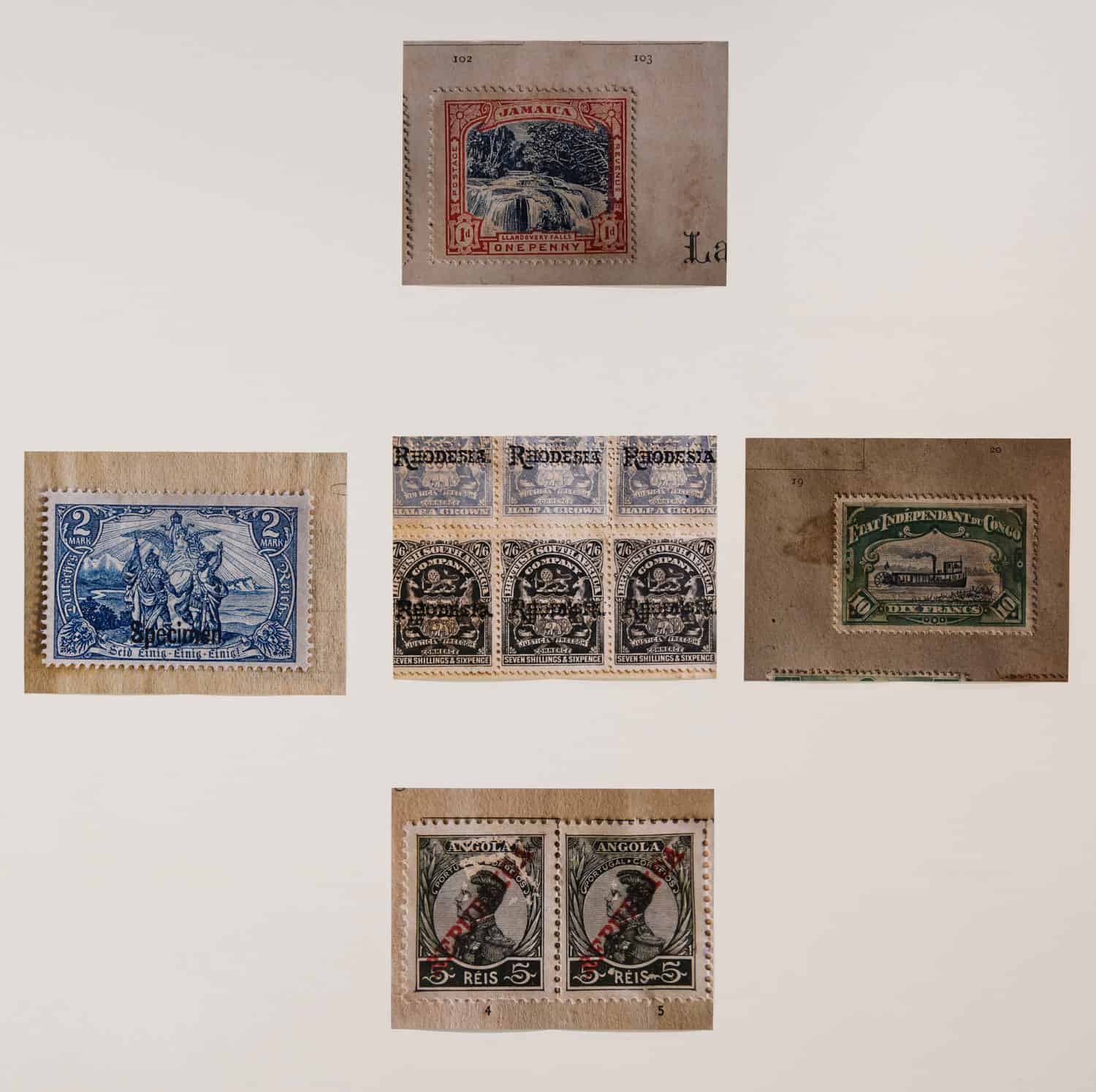
Zarina Bhimji, Lead White (detail), 2018. 111 C-print photographs (Colour Chromogrenic mounted on paper, magnets); 2 embroidery works; overall dimensions variable. © Zarina Bhimji. All Rights Reserved, DACS/Artimage 2020. Photo: Shanavas Jamaluddin, Sharjah Art Foundation.
Brendon Bell-Roberts: I recently surveyed your exhibitions at the Sharjah Art Foundation’s (SAF) Al Mureijah Art Spaces, your first solo exhibition in the region and the most in-depth survey of your work to date, which unfolds across the three galleries. Can we start by exploring the title ‘Black Pocket’?
Zarina Bhimji: The idea of a black pocket was a way of thinking about my approach as if it were painting. Also, the colour black, if you were painting, has so many shades of black. And, in the 17th century, women didn’t have pockets – and pockets keep secrets. If you look inside the pocket or put your hand in the pocket, you get a different feeling of intimacy. These are some of my thoughts that capture my approach to working and looking at the pockets’ history. We use them, what they feel like, and the painterly form, where there are so many black shades that you can create, be it greenish or pinkish. However, still, the colour could translate as black.
The title ‘Black Pocket’ means you imagine what ‘Black Pocket’ means to you. I don’t tell the audience that this is a political work or any other kind of work. Central to my work is research, but in the end, it becomes very much about tone, colour, texture, and intimacy. I invite visitors to come into the exhibition with an open mind and for their imagination to create relationships with my work.
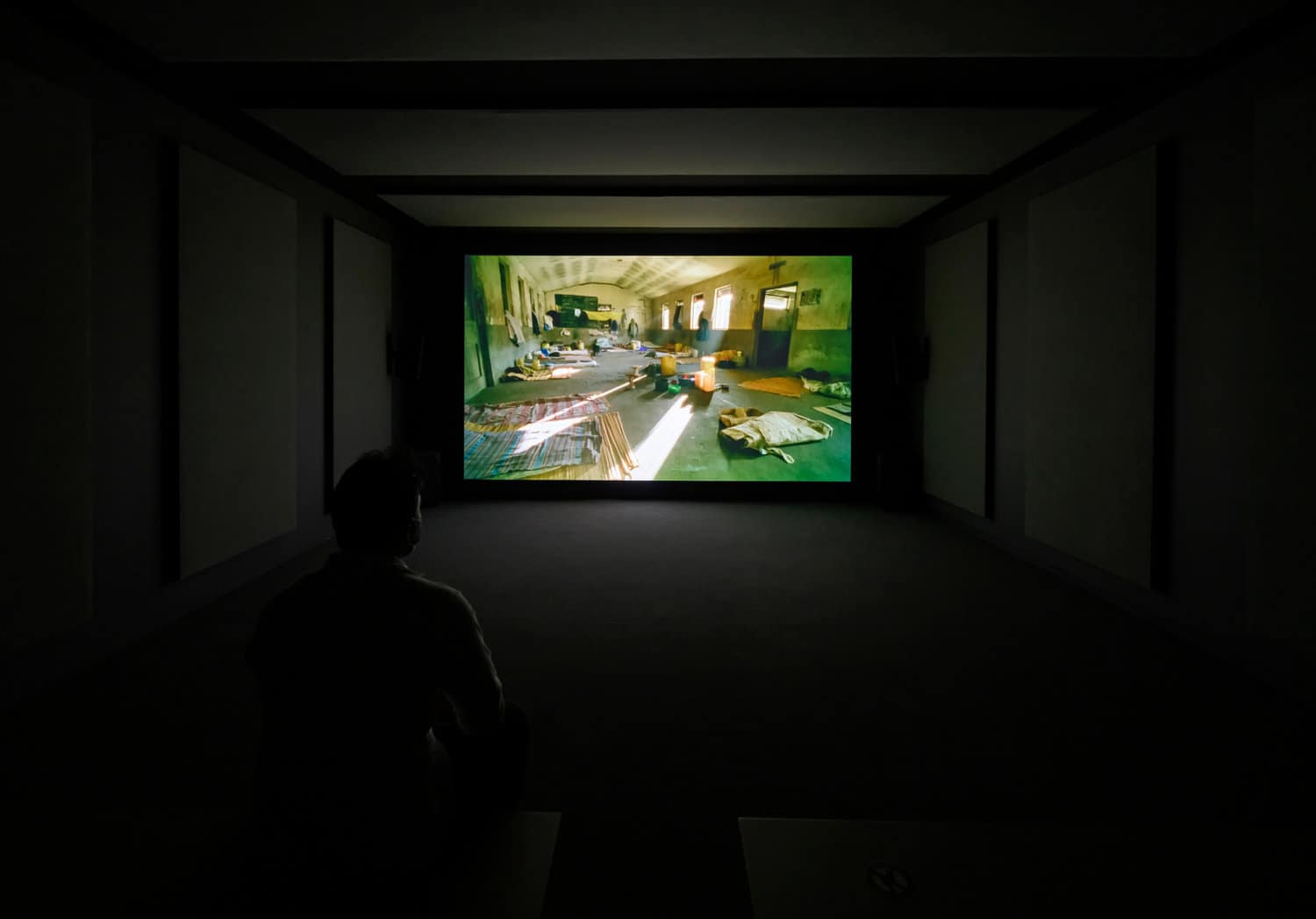
Zarina Bhimji, Out of Blue, 2002. Single screen installation; Super 16mm colour film, DVD transfer; 24 min 25 sec. Installation view: Sharjah Art Foundation. © Zarina Bhimji. All Rights Reserved, DACS/Artimage 2020. Photo: Shanavas Jamaluddin, Sharjah Art Foundation.
Your early practice explores forms of knowledge overlooked by established systems of order. With your later inquiry, you look at architecture and landscape as arbiters of complex experience and emotion. Could you talk about this shift in focus and your artistic approaches here?
At this stage, maybe I should first discuss how I do my work and how it unfolds – perhaps that might answer the question better. I’ve always worked outside of studios. It is very anthropological – an open-air studio approach. If you take Black Pocket’s idea, I will start thinking, ‘what is a pocket?’, and to start with, I would go off and research the pocket.
So, when I get an idea for new work, the early stages involve reading in the library, creating lists and collecting material before I embark on a recce. These recces can be long, sometimes six weeks often travelling alone. They are like a pilgrimage. I want to discover things for myself because, in the library, certain information is always missing.
By going to these locations, other forms of information start emerging. I take a lot of images, often working with film rather than digital. I also have my iPhone to keep a record while I write and gather information.
When I travelled to the Kenya Railways, I got off at every station to document the architecture and what fascinated me most was the staff houses. I then began to question what inequality is and how I talk about it intimately. I wanted to express it in a painterly way, with light, composition, and sound. I also used sound recordings of mosquitos in the film Out of Blue when I wanted to talk about the feeling of claustrophobia. And for my relationship with the landscape, which is very physical, I used the sounds of a Magnetic resonance imaging (MRI) scan to illustrate a metaphor for a disturbance on an emotional level – which can also be emotional disturbances to the landscape. I am not saying that it is, but sort of like colonialism. I wanted to understand the psychotic European form, the measuring, the colonisation. Then I get interested in what troubles, ‘What disturbances does it have?’, ‘Why is it a particular elder generation is experiencing disturbances, like mental health issues?’ It was important to use the Swahili language in the musical score.
I also tend to go back and forth with my ideas. They are not straight forward. Visually and after I have digested that, I will think about preparing my film, the recce research. When I go to do the film, the material has become so much a part of me by then. The study has grown in my head so much that I can physically inhabit it, so I don’t think about it. I shoot the film and often shoot it on 35mm film for its textural quality and creaminess. And we film mute. Walk around with a small boom, work with a lot more crew, because I do many recce’s, I work with people that I met on location.
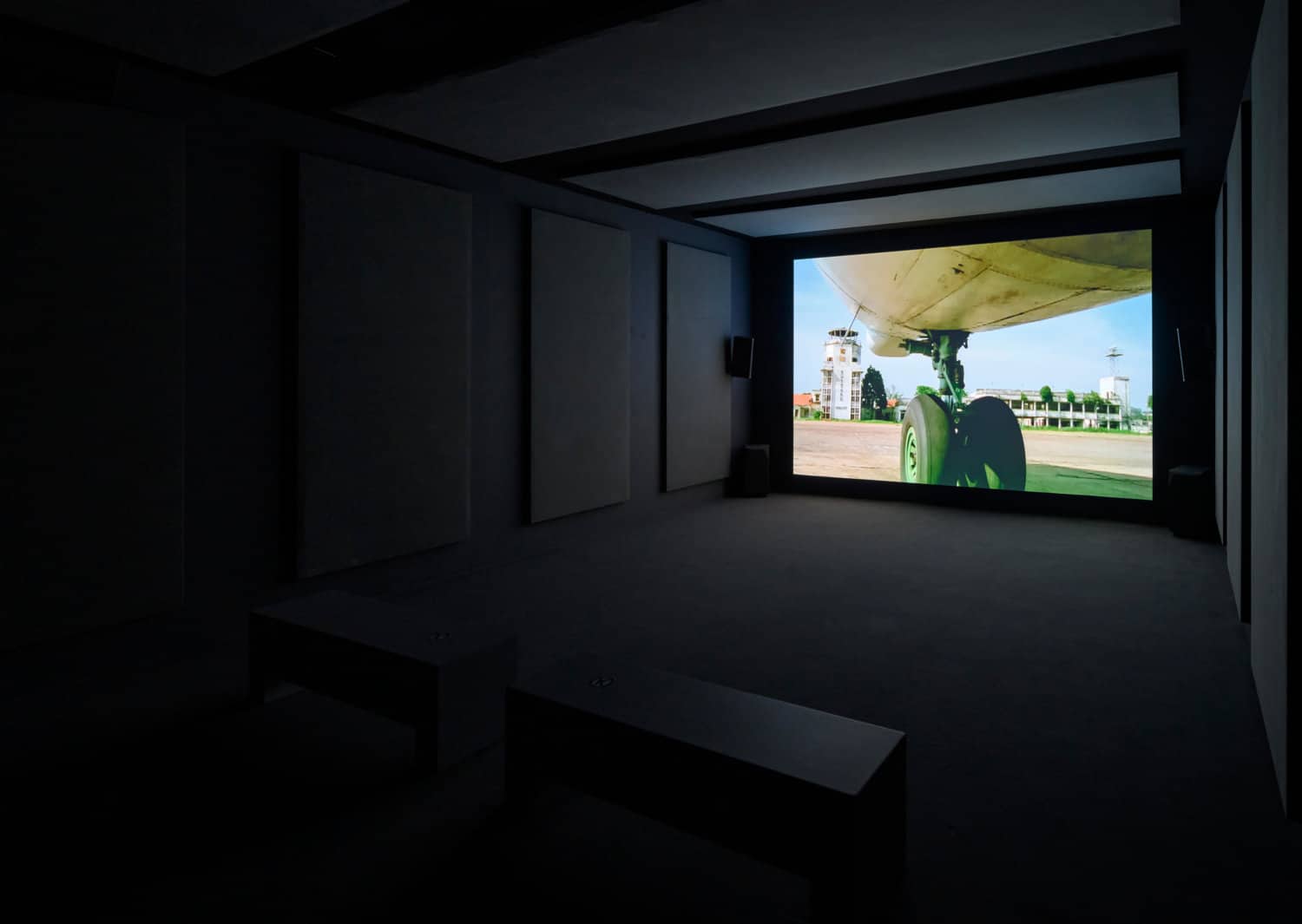
Zarina Bhimji, Out of Blue, 2002. Single screen installation; Super 16mm colour film, DVD transfer; 24 min 25 sec. Installation view: Sharjah Art Foundation. © Zarina Bhimji. All Rights Reserved, DACS/Artimage 2020. Photo: Shanavas Jamaluddin, Sharjah Art Foundation.
When we shot Out of Blue, I met a person from the Ugandan Police, and he became a fixer for me. I don’t particularly like working with officials (fixers). The Ugandan Police in Uganda would set up everything. For example, he could set up a gunshot in the middle of nowhere for me to record the sounds of guns. I could say what type of gunshot I wanted. I am saying this, the research, collating information from people or learning about locations, trees, history – like knowing what guns were popular in Kenya during a specific period.
And also, how I use the material is essential because another example is Lead White. I have never embroidered with photography. The idea to use those materials came out when I was sitting in the archives and looking at some old maps.
Hoor Al Qasimi says of your first film, Out of Blue, commissioned by documenta11 (2002) at the invitation of the late curator Okwui Enwezor and the scholar Sarat Maharaj, that the exhibition offered the opportunity to make a film that opened the door to a new way of working for you. Can you elaborate on what she meant by this?
When I talked to Okwui and Sarat about my ideas for documenta11, I wanted to make a film, Out of Blue. I felt an urgency for this work to be made, and they both agreed and supported me in every way. They sat by my side to support and enable. It is a skill of a good curator to take risks for the cause of making art. I had never made a film before, but they believed in my potential. We had shared values and felt that there was equality in the discussions, and I could speak openly without explaining myself. Sarat said that I talked in gestures, and they understood that. I felt the intense commitment was there, which gave me the confidence to push myself. Sometimes you don’t think that way when you are commissioned to do work because people are not always engaging with you. It’s imperative when I make work that it comes from research and personal reflection space and not from one where I need to explain my position. In my work, I like to move the structure. As an artist, you chose that agency. To intervene.
During my research for Out of Blue, I researched international newspaper articles at the British Library Newspaper Library at Colindale, United Kingdom, to see how “Asians leaving Uganda” was reported. I looked at the period 1972-1974. I was interested in how this was written and spoken about. How different countries reported differently. I was interested in understanding the colonial relationship of how Britain had made arrangements with Ugandan Indians from their time in India. I read a PhD thesis written by an African student talking about housing and the different types of housing in Uganda, such as in Jinja. This inspired me to think about architecture, skin, vulnerability, protection and intimacy. The thesis became important in understanding class and power politics between the British, Indians and Africans. What sound did it make? I recorded sounds of mosquitoes, guns, rain, etc.
The research is background preparation – a little bit like going for a walk to clear your mind. I wanted to give the work intimacy because I felt that it would connect to people more and that I didn’t privilege anybody. During this time, every day for two years, I listened to the music of Abida Parveen. She is a Pakistani Muslim singer, composer and musician. Her Sufi ghazals and qawwali recitations of love and surrendering were a great counterpoint to politics. I also read books by, for example, Moses Isegawa and J.M. Coetzee. This film installation is fictional. It is not a personal indulgence but a question of aesthetics. These ethical questions are very close to my heart.
The subject of how Madrasas teach Islam and religion has stayed with me. The little bodies, with their beautiful gestures, have a flow that is like listening to music.
I factually wanted to understand what sort of torture was used by the military and the police during Idi Amin’s regime. I wanted to understand the German architecture of prisons. Some Ugandan prisons – where I filmed – were built by Germans and some by British. The person who found me the landscape location in Out of Blue said that as a young girl at school, she had to hide in the water tanks whilst Amin’s army were shooting outside. I found out about this woman through Madrasa schools. She ran the Madrasa in Kampala. Since then, the subject of how Madrasas teach Islam and religion has stayed with me. The little bodies, with their beautiful gestures, have a flow that is like listening to music.
Once I’ve done this research, I leave it behind. I hope the work is removed from the historical specification as I sieve through to arrive at a precise and contained form, removing all superfluous. It is very much to do with the aesthetics, the light, the piece of string unravelling. Out of Blue was my first film, and I was surprised by how easily it came to me. Once my father passed away, I wanted to make sense of this history, not forget it. The Indian presence in Uganda added something else to it, and there was also the fact that I was born in Uganda. I made the work Untitled (A Sketch) to understand father/daughter relationships and cartography. I looked at the news to understand how the World Bank dealt with Indians returning to Uganda. I worked with my Director of Photography, who really pushed and stretched me with his many questions to understand my ideas. He enabled me to be vulnerable with him. I shot the film mute so that we could add the sound to it at a later stage. I worked with a composer to design the sound. I recorded lots of sounds and gathered sound from the archives. This was my first time shooting and editing film and working on sound. The whole process I went through wouldn’t have been possible without Okwui and Sarat’s support and the other co-curators on the documenta11 team.
Fatima wanted to work with her camera. She wanted to use a macro lens. For her light is the subject matter, through colour, line, tone and composition. Beauty is powerful and it’s not linear. She wanted to find the subtexts to the words ‘East Africa Protectorate’. She was interested in details such as the embossing of the word ‘Deutsches’, its colour, its texture, and how it reminded her of sounds and voices in Europe. She was in the world of ‘God and my lawful right’, ‘Dieu et ma main droite’, ‘Dieu et mon droit’; with red ink ‘KENYA’, ‘God and my right’, ‘Honi soit qui mal y pense’, ‘May he be shamed who thinks badly of it’, ‘Shame be to him who thinks ill of it’. ‘Protectorate’ means a state that is controlled and protected by another. Fatima wanted to feel the fibres of the paper, the writing, the colour of the ink. She wanted to read the letters again and again. She wanted to feel the force with which it all happened. The purple ink was terrifying. It was like opening exam results. She could feel in her hands the power of an authority that could quite easily get rid of her and wipe away any evidence, an authority that could rewrite an event with a different account and she would just have to accept it. It was the terror of authority.
– An extract from Zarina Bhimji’s monograph, Lead White
I always have Gujarati title text at the start of the film, subtitled in English. I want to ask the question, “What is a translation?” When we are translating something, what is being lost or understood? It always interests me that curators don’t really understand that I might have researched this project for two years and used a medium format film camera to stand in those spaces and visually grapple with some of these questions formally. For example, I was given full access to the old Entebbe airport, where the Israeli Entebbe raid took place. I worked very quietly on my own for days. Another example is the photograph, Echo, which is not being shown in the SAF exhibition. It is trying to understand what it is like to be homeless and from Rwanda. I could express that by looking at and studying the graffiti and drawings on the walls done by homeless families. I feel that these drawings are like diaries, echoes, marks. They become part of my imagination about how to compose the image, what colour to give it, how to print it at scale. These photographs are done on my research trips. I bring them back to the studio and work on them further before shooting my film.
Commissioned by SAF for the Sharjah Art Foundation Collection and presented in Al Mureijah Art Spaces is the work Lead White, ten years in the making. Elaborate on this process and what it entailed. Can you share some of your personal experiences and findings during this period?
Sometimes when you’re doing work, you don’t even know you’re making it, and you’re thinking about things that you don’t even know will eventually become an artwork or part of a work. This happened to me when I was doing the work, Lead White.
I would also go to the archives for added material, and then I found I was still drawn to the archive after I finished making all these films. I have worked in numerous archives like the British Library archives, in archives in Scotland and Bombay. Still, I was especially drawn to the National Archives of Zanzibar because they gave me full access. I was also partly drawn to working there because the archive was deteriorating. I felt that it was essential to making this information known should it be lost forever.
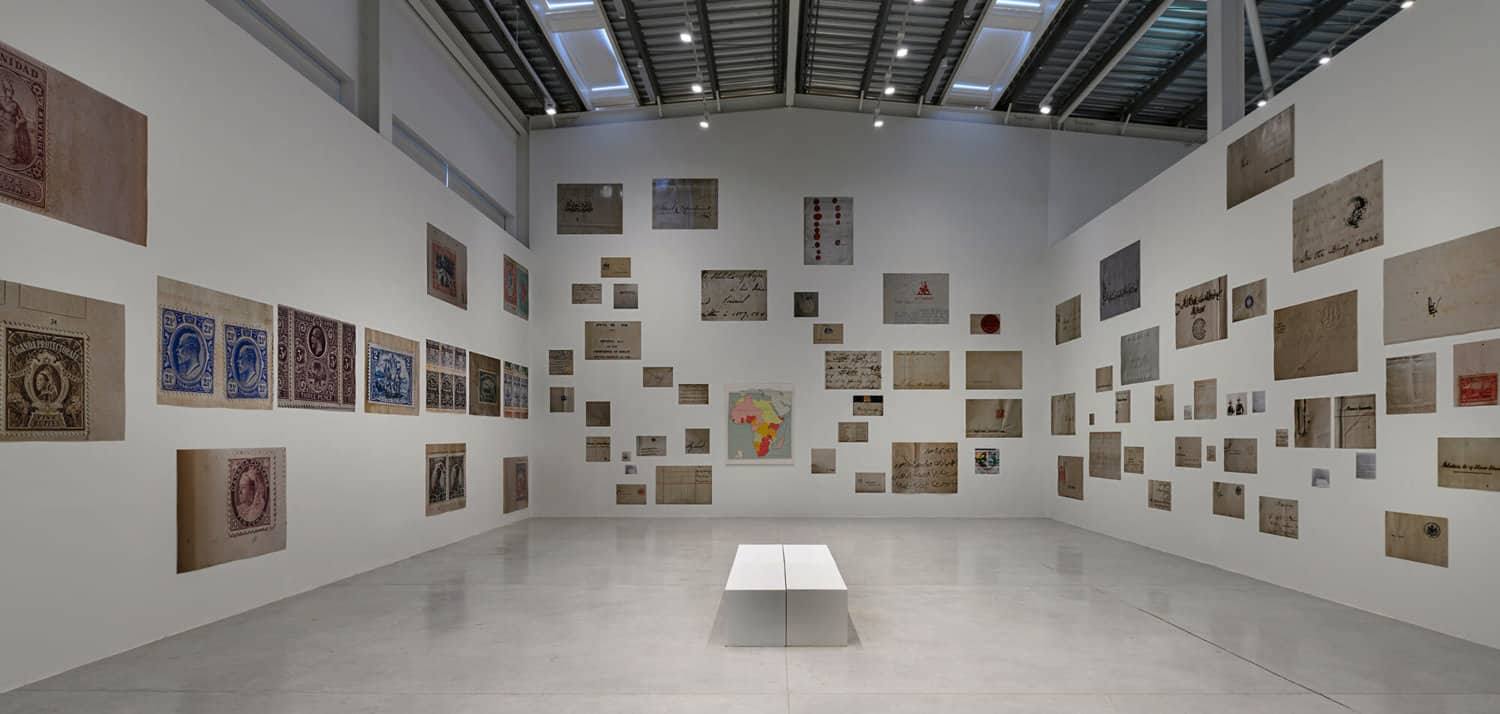
Zarina Bhimji, Lead White (detail), 2018. 111 C-print photographs (Colour Chromogrenic mounted on paper, magnets); 2 embroidery works; overall dimensions variable. © Zarina Bhimji. All Rights Reserved, DACS/Artimage 2020. Photo: Shanavas Jamaluddin, Sharjah Art Foundation.
I visited Zanzibar for more than a decade and developed many friendships, relationships with curators, and support. I set up my camera and a small studio there, which gave me space to work, set up internal conversations, and keep the many discussions going. I also took many photographs that I could edit later, so it was during this time documenting books and titles that I started to think about pre-colonial times.
In the limited-edition artist’s book I produced for Lead White, initially shown at the Tate Modern, I wrote a short story about making this work. In it, I wrote a short descriptive story about what it was like to do this work. I describe how the work happened, how it developed, like if I took photographs and forgot how to make them – because I have been working on the film. When I came to hang the exhibition, it became one piece (one work), so all the different elements had to be considered together. I wanted the embroidery works to disappear like in photography.
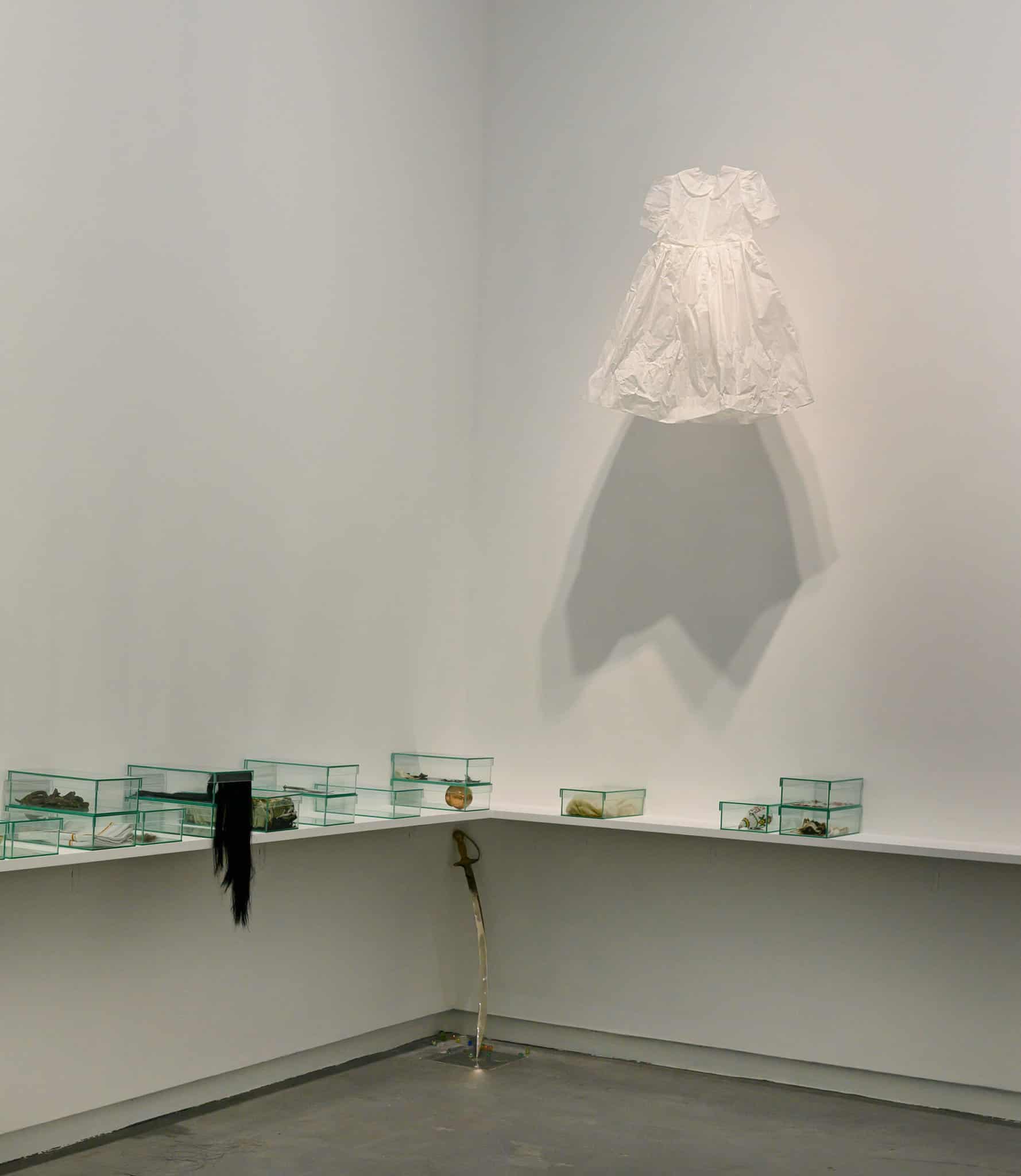
Zarina Bhimji, I Will Always be Here, 1992. 85 glass shoeboxes containing fabric, chillies; cut hair; round chillies; pubic hair; copper utensils; coloured spices; 3 black-and-white photographs; saffron; chiffon fabric; hair; swords; green, yellow, blue, orange marbles; wisdom teeth; orange and yellow balloons; more hair; clay pot; shrivelled carrots; hair bun; coconut; embroidery; burnt sari; knife; broken red glass bangles; fabric with red border; text; roses and tissue paper dresses; overall dimensions variable. Installation view: Sharjah Art Foundation. © Zarina Bhimji. All Rights Reserved, DACS/Artimage 2020. Photo: Shanavas Jamaluddin, Sharjah Art Foundation.
This exhibition presents work (1986-2020) that engages with institutional power and vulnerability, universality and intimacy. Given the world today and looking back at your practice, do you see any specific major shifts around these issues? If so, what are your observations on our current condition?
I suppose the Black Lives Matter movement (BLM) was a decisive action, was about being able to speak from the inside and act. My interest has always been about looking at institutional questions, like ‘What is equality?’ and how can we look at that in terms of illiteracy and medical care.
It is not easy to challenge an institution, and I think that things are so complex that I think I cannot make this challenge easily, but what I can do is speak in my language, in my terms about this, and hopefully create debate. Still, I think it’s not easy to challenge institutions. If you look at BLM, you can tell that it is not easy. There is still poverty, so maybe I am too idealistic about these things, so I ask myself questions like, ‘Are you too idealistic?’
During the lockdown, people have been more insular, giving them more time to think about humanity’s serious issues and our collective futures? Do you think society will finally address some of these challenges?
I hope so, but I am not sure. My theory is that the way to make things equal is to ensure equality in education for women and people of colour, access to medical care, housing, and food. In London, there is a wider gap in terms of people not being able to feed themselves. To have access to the before-mentioned things is essential if we are to build better societies. As an example, I am the product of free education.
‘Zarina Bhimji: Black Pocket’ was on view at Sharjah Art Foundation in Galleries 4, 5 & 6, Al Mureijah Art Spaces, from the 2nd of October until the 10th of April 2021.



